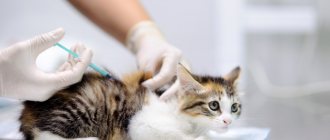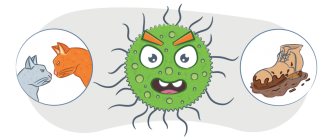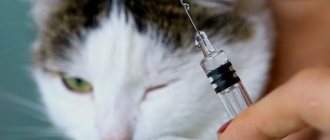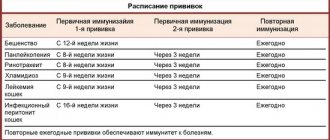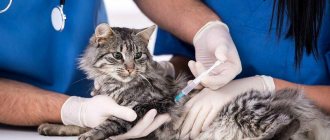Caring for your pet’s health is expressed not only in proper care and feeding. It is important to prevent your cat from becoming infected with dangerous infectious diseases, primarily rabies. This is a fatal disease that can only be recognized at a stage when treatment is no longer useful. Moreover, a cat with rabies will become dangerous to others, and rabies is no less dangerous for people. If a person bitten by an infected animal shows symptoms of this disease, then this is already 100% fatal, the only question is time. Therefore, rabies vaccination is the only way to protect against this disease.
Content
- Types of rabies vaccines
- At what age can cats be vaccinated?
- How to prepare an animal for vaccination
- Post-vaccination period
Does a domestic cat need vaccination?
If an animal is walking on the street, a responsible owner will not even think about the need for vaccination. But if a cat lives in an apartment and does not have contact with street animals, is it really necessary? Veterinarians say that it is necessary, since there is still a risk of infection.
In what cases can a pet become infected with rabies?
- The cat runs out into the street through an open door, there is a possibility of contact with a sick animal.
- There are frequent cases of animals jumping out of windows, with the same consequences.
- Mice and rats often live in apartment buildings, and rodents can also be carriers of rabies.
- If owners take their cat with them to the dacha, the likelihood of the pet meeting a sick animal increases significantly.
In addition, your cat will need vaccinations if you take it with you on a trip. In this case, a mark is placed in the veterinary passport no less than 30 days after vaccination. The mark is also required for the animal to participate in exhibitions.
Vaccination of cats against rabies
Rabies is transmitted by contact with the saliva of a sick animal through a bite, as well as through wounds and scratches.
The virus can penetrate through a small injury on the skin or mucous membranes, and the closer to the head the infection occurs, the faster the disease develops. The reason lies in the fact that the rabies virus destroys nerve cells in the brain, spreading along neural pathways. Specific inflammation of the brain leads to the appearance of signs of rabies: drooling, hydrophobia, photophobia and hallucinations. Cats, like other carnivores, can become infected with rabies from an infected animal and pass the disease on to their owners. It is precisely because of the high danger to humans that rabies is a quarantine disease, immunization against which is mandatory for all cats and dogs. Prevention of rabies is carried out annually, and the animal can be vaccinated with the rabies vaccine or the monovaccine “NOBIVAK R”, “RABIZIN” or complex drugs in combination with the viruses “NOBIVAK TRICAT Trio”, “KVADRICAT”.
Types of rabies vaccines
Several types of vaccines are used in veterinary medicine. All of them are multicomponent, that is, after one vaccination the animal receives immunity from several diseases. The price of the vaccine depends on its type. The following drugs are common today:
- Nobivac Rabies. A multicomponent vaccine that protects against rabies, rhinotracheitis, panleukopenia (distemper), and calcivirosis. The first vaccination is given no earlier than 8 weeks of age. Stable immunity is formed after revaccination, which is carried out after 3 weeks. One dose costs about 370 rubles.
- Quadricate. Complex vaccine against rabies, panleukopenia, respiratory diseases. The drug does not contain live strains, so it is easier to tolerate and completely safe. Vaccination is carried out at 4 months, revaccination is carried out annually. One dose costs about 600 rubles.
- Defensor 3. Provides lasting immunity against rabies. It is administered once, to kittens from 3 months of age. Revaccination needs to be done every 3 years. The cost of one dose is about 100 rubles.
- Rabisin. Used to prevent rabies in many animals. Cats are administered twice - the first time from 3 months of age, the second time a year later. The cost of one dose is about 200 rubles.
It is difficult to say which vaccine is the best. All of them are high quality, tested. The choice of drug is based on the individual characteristics of the pet, the capabilities of its owner, and the desired effect.
In what cases should vaccinations not be given?
Vaccination is carried out only to clinically healthy animals, therefore any symptoms (fever, vomiting, diarrhea, discharge from the nose and eyes, sneezing, mouth ulcers, general malaise, refusal to eat, etc.) are a contraindication to vaccination. Animals receiving immunosuppressive therapy (cyclosporine, glucocorticosteroids, chemotherapy drugs) cannot be vaccinated; the interval between the last administration of the drug and vaccination must be at least two weeks. To avoid disorders of the central nervous system (damage to the cerebellum - cerebellar ataxia), it is strictly forbidden to vaccinate kittens before 6 weeks of age with the feline panleukopenia vaccine (FPV). Pregnant cats cannot be vaccinated with a modified live vaccine against feline panleukopenia, as there is a risk of transmission of the virus to fetuses and the development of intrauterine pathologies in them. Cats with severe immunodeficiency (eg, feline leukemia virus or viral immunodeficiency) should not be vaccinated with live vaccines because loss of control of viral replication may result in the development of clinical symptoms after vaccination.
At what age can cats be vaccinated?
The first vaccination is given at 3 months, unless there are indications for earlier vaccination or, conversely, contraindications. This period is due to the fact that the kitten’s body contains antibodies received from its mother, and only from 8 weeks their level decreases. There is a risk of infection from the first days of life, but it is not advisable to vaccinate a newborn kitten - antibodies transferred from the mother destroy some of the microorganisms introduced with the drug, and its effectiveness decreases. Therefore, the optimal age for rabies vaccination in cats is 3 months. If vaccination was carried out earlier than 3 months, it is repeated in due time. It is acceptable to vaccinate pets at 4-5 months.
As is clear from the above list of drugs, each has its own characteristics and duration of action. But, mainly, the vaccine is administered once, and revaccination is required every year.
Urgent measures
If the cat behaves somewhat unusually, especially if it is able to freely go outside the apartment or house, then it is advisable to urgently visit a veterinary clinic. A test for rabies exists, but is not routinely performed because a negative result does not guarantee the absence of the disease. Therefore, if rabies is suspected, the veterinarian will quarantine the animal and monitor the symptoms. If the doctor understands that the cat is not sick with rabies, then she will be given help. Otherwise, the veterinarian waits for the death of the animal to examine the brain tissue for the presence of Babeshi Negri bodies and make a diagnosis of RABIES. The owner must go to the clinic and undergo a course of anti-rabies or rabies injections.
It should be noted that treatment of rabies is prohibited, since there is a high risk of infection of veterinary clinic staff.
How to prepare an animal for vaccination
To ensure that the procedure does not cause complications, the cat needs to be prepared. The range of events includes:
- Anthelmintic drugs - these are given 2 weeks before visiting the veterinary clinic.
- Ridding an animal of fleas.
- Monitoring the pet’s condition a few days before vaccination - appetite, well-being, condition of the coat, eyes, ears should be normal.
- On the eve of vaccination, the cat's body temperature is measured.
Video on how to measure an animal's temperature at home:
Before giving the injection, the doctor again measures the temperature, collects anamnesis, and examines the pet. If there are no contraindications, vaccination is carried out. If it is repeated, you need to vaccinate according to the same rules.
Contraindications to vaccination are:
- increased body temperature of the animal;
- individual intolerance to the components of the drug (an allergic reaction to the vaccine is possible);
- recent or acute infectious diseases (quarantine);
- exacerbation of a chronic disease.
Possible complications after vaccination
Complications after vaccination against rabies in a cat can occur if the animal was infected with other infectious diseases at the time of vaccination.
In the first hours after vaccination, the cat becomes lethargic, and by the end of the day, the clinical signs of this disease can begin to develop rapidly - they manifest themselves in a more severe form and even end in death.
Important! Unfortunately, during mass routine vaccinations of cats against rabies, veterinary specialists do not have the opportunity to examine all animals for hidden pathologies or infections. Therefore, owners should closely monitor their pets. If there are deviations from the norm in their behavior or health status, it is necessary to reschedule the vaccination.
10-14 days before rabies vaccination, the animal must be dewormed and treated against ectoparasites. On the day of vaccination, it is necessary to measure the cat’s body temperature to ensure that there is no illness.
Allergic reaction
The manifestation of an allergic reaction in response to rabies vaccination in cats occurs within 15-20 minutes after vaccination. It can be expressed in the following forms:
- profuse salivation;
- hyperemia of the mucous membranes of the eyes and nasal cavity;
- lacrimation;
- increase in local body temperature in the area of vaccine administration;
- the appearance of swelling in the head area;
- skin rash, itching;
- redness and thickening at the injection site;
- one-time vomiting or diarrhea.
If the cat is intolerant to the components of the vaccine, the first vaccination may cause complications in the form of anaphylactic shock or loss of consciousness.
Important! In most clinics, owners are asked to stay for 20-30 minutes after vaccinating their cat. The purpose of this is to monitor the condition of the animal and the possibility of providing timely qualified assistance in the event of the development of allergic reactions or other complications.
It is especially necessary to carefully monitor the kitten’s health during the first vaccination. In case of any deviations, you should immediately contact a veterinarian.
If the first rabies vaccination caused complications in the cat in the form of an allergic reaction, then subsequent vaccinations are carried out while using corticosteroid drugs.
Applying a vaccine to a virus
The most dangerous consequence of vaccination in cats is the pet contracting rabies. This can only happen if the animal was already infected with the rabies virus at the time of vaccination.
Important! The rabies vaccine for cats is a preventive measure and has no therapeutic effect. Therefore, the clinical signs of this disease appear against the background of vaccination, but are not its consequence.
There is a clear rule that will help prevent such a situation. According to it, after a new animal is brought into the house, it must be kept in quarantine for two weeks. During this period, you should carefully monitor any changes in the cat's behavior.
Very important! A sign of the latent stage of rabies may be excessive affection or intrusiveness of the pet. This often confuses owners, as the classic symptom of this disease is aggressiveness. Confirmation of the presence of rabies in a cat can also be eating inedible objects.
If no clinical symptoms have been identified during the quarantine period, the cat can be vaccinated against rabies without restrictions.
Lameness
Sometimes a complication after a rabies vaccination in a cat is lameness. This is due to the fact that during the injection the needle hits the nerve. A similar situation can arise even for an experienced specialist, when the animal behaves restlessly and strongly strains its body muscles. In most cases, lameness goes away within 1-3 weeks.
Most often, such a complication from vaccination occurs in a kitten due to the small amount of muscle tissue on the hind legs.
Sometimes owners cannot understand why a cat's hind limbs fail after a rabies vaccination. This symptom indicates damage to a major nerve. If after 2-3 days the pet still does not get up on its paws, you should contact the clinic.
If the reason why a cat's hind limbs fail after a rabies vaccination is damage to a large nerve plexus, then paresis or paralysis may develop. In rare cases, the animal can be helped through timely treatment with medications and physiological procedures. But lameness can remain for life.
Some experts believe that after immunization, a cat's back legs fail due to stress. But this theory makes sense only if, after relaxation, the animal’s motor functions of the limbs are restored.
Local inflammatory reaction
The reaction to rabies vaccination in kittens and adult animals can be expressed in the form of local inflammation in the injection area and is a natural response to an adjuvanted vaccine. This substance promotes blood flow to the injection site to enhance the body's immune response.
If redness, swelling and increased local temperature go away within 5-7 days, then do not worry. But if the inflammatory reaction to a rabies vaccination in a cat is complicated by the penetration of pathogenic microflora, then the intervention of a veterinary specialist is necessary.
In order to minimize the risk of purulent inflammation, you should carefully monitor compliance with all antiseptic rules during vaccination. This list also includes the use of disposable injection syringes.
Note! The French vaccine PureVax Feline Rabies Vaccine does not contain adjuvants, so it almost never causes complications. However, the high cost of the drug does not allow its use in mass vaccinations by state veterinary services.
Post-vaccination feline sarcoma
The most dangerous and severe complication from vaccination with the rabies vaccine in cats is post-vaccination sarcoma. This pathology is manifested by the formation of a malignant neoplasm at the injection site.
The “insidiousness” of this type of tumor lies in the long latent phase, which lasts from several months to 2-3 years. After the first clinical signs of the disease appear, the sarcoma begins to grow rapidly and increases tenfold in 3-5 weeks.
With a timely operation to remove the tumor with a large area of excision of healthy tissue around it, it is possible to avoid the formation of metastases.
Experts agree that sarcoma is provoked by local inflammation caused by the adjuvant during vaccination.
Post-vaccination period
Usually the vaccine is administered intramuscularly, less often - subcutaneously. The standard dose volume is 1 ml. If the preparation is carried out correctly, the animal’s well-being remains normal. It is possible that the cat’s activity may be suppressed for 2-3 days, but this is not critical, and the animal’s condition will improve on its own.
A lump may form at the injection site if the drug was administered subcutaneously. It resolves on its own within a week. After intramuscular injection, swelling does not form.
Negative consequences after vaccination are possible, but only if the animal is not properly prepared and the procedure is carried out without taking into account contraindications. Serious complications are allergic reactions (anaphylactic shock), which cannot be foreseen if a particular drug is used for the first time. Therefore, after the injection, the animal must remain in the clinic under the supervision of a doctor for 20 minutes.
Rabies is a serious and dangerous disease for both the pet and its owner. Therefore, it is necessary to vaccinate your pet, regardless of whether it is walking outside or not. To save time and reduce stress in the animal, it is worth using multicomponent vaccines - they will provide immunity against several diseases, and you will not have to visit the veterinarian often.
Well-being and normal reaction of the cat to vaccinations
Modern vaccines are quite safe, and adverse reactions from them are extremely rare. Normally, if all vaccination rules are followed, which include a mandatory examination of the animal by a veterinarian, anamnesis collection and an individual approach, the cat’s well-being after vaccination does not change, and the appearance of a lump at the injection site is acceptable. Also, the kitten’s behavior after vaccination most often remains the same, but in rare cases the baby is slightly lethargic.
After a rabies vaccination, a cat may be lethargic for the first day, a slight and short-term increase in body temperature is acceptable, and a lump may appear at the injection site for several days.
Is vaccination of people after a bite always effective?
“Anti-rabies antibodies produced by vaccination after a bite are only effective if they are administered before the rabies virus enters the nervous system.”
Rabies antibodies produced by vaccination after a bite are only effective if they are administered before the rabies virus enters the nervous system. Once in the nerve cells, the virus spreads along the nerve fibers, where it is protected from attack by antibodies. Therefore, the use of the vaccine is important for people who have been, or may potentially be, bitten by a rabid animal. Of course, for people who are potentially at high risk of contracting rabies (such as veterinarians and wildlife control officers), it is preferable to be vaccinated in advance.
